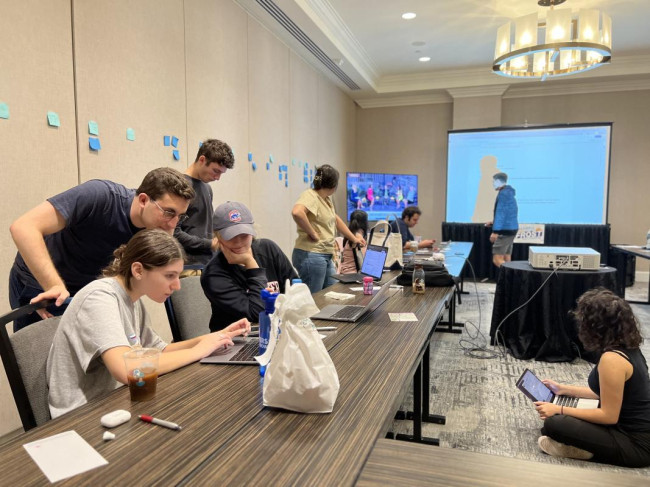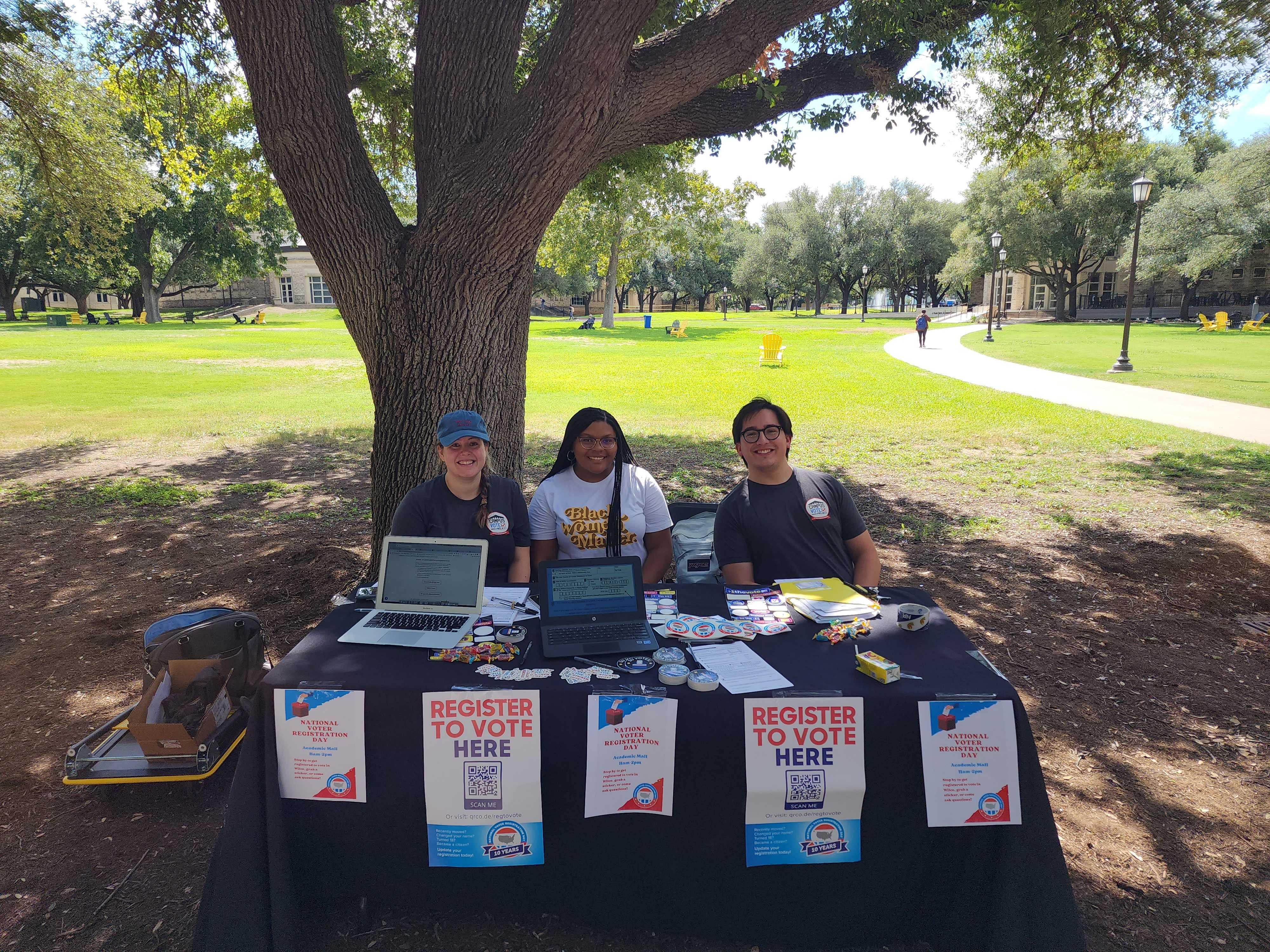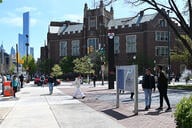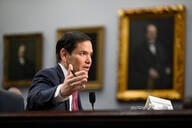You have /5 articles left.
Sign up for a free account or log in.

Student leaders of Voters of Tomorrow hunker down in their “war room” in Washington, D.C., the day before the midterms. Experts say peer-to-peer engagement has the potential to spur higher turnout among college students.
Jack Lobel
On the eve of today’s midterm elections, a crack team of political organizers assembled in a “war room” at a hotel in Washington, D.C., from which they spoke to the press, monitored election disinformation and suppression, and helped thousands of on-the-ground volunteers coordinate get-out-the-vote efforts.
They weren’t Democratic or Republican Party strategists. They were college students from all over the country, members of a student-led organization called Voters of Tomorrow, whose goal is to promote voter turnout among college-age youth. Some were so young they had never cast a ballot before; they planned to do so today, amid another full schedule of mobilizing student voters.
Jack Lobel, the organization’s 18-year-old deputy communications director, said he believes that as a voting bloc, college students are more important than ever and are poised to be a major factor in the outcome of today’s elections.
“There’s this narrative that young people don’t vote, and it’s pretty harmful,” Lobel, a freshman at Columbia University, told Inside Higher Ed from the Marriott, where he said over a dozen student leaders were gathered. “We’re trying to show young people that we have a real opportunity to make our voices count.”
In 2020, 66 percent of college students who were registered to vote cast their ballots, a 14 percent increase from 2016—and the first time in a decade student turnout matched the general population's rates, according to data from the Institute for Democracy and Higher Education at Tufts University. In January 2021, young voters in Georgia’s special election were crucial in handing Democrats the slim double victories that gave them control of the Senate. And during the last midterm election in 2018, college student turnout more than doubled what it was in 2014, from 19 percent to 40 percent.
This year, voter registration among 18- to 24-year-olds surpassed 2018 levels in many states, according to data from the Center for Information and Research on Civic Learning and Engagement at Tufts.
Politicians, it seems, are taking notice of students’ growing electoral influence and doing their best to keep them coming to the polls. President Biden even made a tour of college campuses as he traveled the country supporting candidates in recent days; in the past week alone he spoke at Florida Memorial University, Sarah Lawrence College in New York, Central New Mexico Community College, Mira Costa College in Oceanside, Calif., and Bowie State University in Maryland.
“Unlike noncollege youth, college students can be mobilized as a bloc because they have a shared identity, whether that’s as college students or as members of a specific campus community,” said Melissa Michelson, a political science professor at Menlo College in Atherton, Calif., and a members of the Student Vote Research Network.
Michelson added that students themselves are most effective at mobilizing this bloc. They know not only how to navigate the technological and cultural spaces their peers occupy but also the best ways to convey the importance of voting.
“I’m a middle-aged professor; I can’t be trusted to know what’s cool,” Michelson said. “The key thing that makes peer-to-peer messaging so effective, especially with young people, is that they trust the messenger.”
Spurred by ‘Both Hope and Fear’
If voting out Donald Trump was a motivating factor for the record youth voter turnout in 2020, issues such as the Supreme Court’s overturning of Roe v. Wade could light a fire under college students in 2022.
A CBS/YouGov poll from June found that 68 percent of people aged 18 to 29 disapproved of the reversal of Roe v. Wade, and 41 percent said they were more likely to vote in the midterms as a result. And in the weeks following the Dobbs decision, voter registration among women under 25 surged in states where the right to abortion was suddenly at risk, including Pennsylvania, Texas and Kansas, where the boost in youth voters helped reject a ballot measure to ban abortion in the state.
Eugenia Agobe, a senior at Southwestern University in Texas and a national programming intern at the Campus Vote Project, an initiative of the Fair Election Center aimed at boosting turnout among college students, said the Dobbs decision has been a major factor in student civic engagement in the state—on both sides of the issue. She added that students are passionate about a number of other issues as well, such as gun control, student debt and the increasingly dire threat of climate catastrophe.
among college students, said the Dobbs decision has been a major factor in student civic engagement in the state—on both sides of the issue. She added that students are passionate about a number of other issues as well, such as gun control, student debt and the increasingly dire threat of climate catastrophe.
In October, a poll from Voters of Tomorrow found that abortion is the top issue for voters between 18 and 24 in battleground states.
“Young people are going to show up this year out of both hope and fear,” Lobel said. “We saw Roe fall, and I think that was really a signal for us … but we are hopeful about our ability to build a better future through collective power.”
“The silver lining of our increased polarization is that it makes really clear the impact politics has on your life,” Michelson said. “I think there’s a lot of potential for college students to be really engaged and turn out [on Tuesday], not in 2020 numbers but maybe closer to 2018 levels.”
Greater Influence, Bigger Challenges
Student voting advocates have more than apathy and logistical complications to overcome in getting undergraduates’ ballots counted. Mike Burns, the Campus Vote Project’s national director, said that while there’s been some positive movement toward increasing voting access for college students, campus voting sites are still scarce. According to a 2020 study he cited from Duke University and MTV, 74 percent of higher education institutions had no campus voting location on Election Day; for early voting, that number jumped to 90 percent.
“It’s just astounding to me, considering that these campuses are community resources in so many other ways, often have the newest technology, are ADA compliant,” he said. “They’re really woefully underutilized for what they could be.”
Burns also said states like Florida, Georgia and Texas have taken steps that effectively suppress college students’ votes. For instance, stricter requirements on mail-in ballots—one of the main ways students tend to vote, since many aren’t registered where they attend college—could lead to more students having their ballots rejected or flagged.
Agobe, who has been working with Campus Vote Project since 2020, said that countering misinformation and providing civic education for students is especially important in states like Texas, where stricter voting laws—including a 2019 ban on “temporary voting locations” and increased scrutiny of mail-in ballots—have made voting from campus more onerous than ever.
“In states like Texas, it’s really important that students know their rights, know what to bring to the polls so they don’t get turned away and know how to push back on people trying to intimidate them,” Agobe said. “Peer-to-peer engagement is a really important tool for getting college students to vote, but it is unfortunate that we have to rely on individual efforts … I think a lot about how the system has failed student voters.”
Agobe and other Southwestern students are also working on positive voting incentives, setting up tables with free pizza and T-shirts outside their campus polling location—at the legal distance, of course.
“We want to make voting feel like more of a celebration than a chore,” she said
Lobel said Voters of Tomorrow has worked to counteract youth voter suppression throughout the early voting period, including by sending a bus to Texas A&M University to take students to a nearby early voting location after the county shut down its campus polling site. He said that work will continue today.
“Young people are disproportionately affected by misinformation and voter suppression,” Lobel said. “No matter how much we plan and mobilize, we’re still fearful of attacks on our democracy. But if our voices didn’t matter, they wouldn’t be trying so hard to shut us down.”





